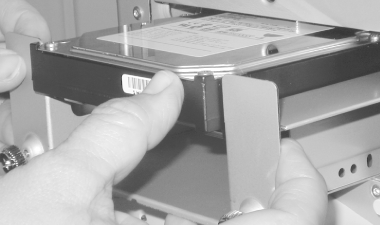28.7 Step 7: Install Other Drives How you mount hard disk drives, tape drives, and optical drives varies from case to case, and may depend on the drive itself and whether or not the drive is to be mounted in an externally accessible bay. Some cases use multiple mounting methods, as follows: - Direct attachment
-
With typical mini- and mid-tower cases, slide the drive into the bay and secure it with screws to the bay itself. Depending on the particular case and drive, you may need to slide the drive into place from the front or from the back. Use the screws provided with the drive to secure the drive. If no screws were provided with the drive, make sure that the screws you use not only have the proper thread, but are the proper length. A too-long screw can project inside the drive enclosure and damage a circuit board or other component. Four screws front and back on each side are adequate, although there may be room to install as many as eight. Although it is not recommended practice, we have sometimes secured a drive with only two screws on the same side when the case design made it difficult to drive screws into the other side. We have never had any problems result from doing this, but if you do it, do so at your own risk. Figure 28-27 shows a typical mini-tower arrangement. The drive in the top bay of this Antec KS288 case has all four screw holes aligned with the corresponding chassis holes, which automatically aligns the drive front-to-back to be flush with the front bezel. Cases built with sloppier tolerances use slots rather than holes to make up for the loose tolerances, although some well-built cases also use slots. Figure 28-27. A typical mini-tower arrangement, where drives secure directly to the chassis   | Ever wonder why stools have three legs? It's because three points define a plane, and a three-legged stool is therefore always stable, regardless of how uneven the surface it rests on. One of our tech reviewers called this to our attention, and notes that when working with inexpensive cases he often uses only three screws to secure a drive because that minimizes the danger of the drive being torqued if the case flexes. He (and we) has seen this happen in cheap cases, and it can lead to anything from intermittent read and write problems to premature drive failure. So if you are installing a drive in a cheap case, consider using only three screws to do so. Better yet, replace the case. |
|
- Removable drive cages
-
Some cases use removable drive cages in which you install drives and then mount the cage with installed drives as a single unit. Drive cages are in all other respects similar to the arrangement described above. Figure 28-28 shows the removable drive cage being installed in the Antec SX840 case, with the hard drive already secured to the cage. This particular drive cage installs from the front and is secured by thumbscrews. Other removable drive cages install internally and are secured by standard screws or by a clamping arrangement. Figure 28-28. Installing a removable drive cage with the hard drive in place  - Drive rails
-
Traditional desktop cases and some tower cases use drive rails, which are secured to the drives and fit slotted channels within the case. Rails are always mounted directly to the drive using screws. The rails may be secured to the case by a screw through the front of the rail into the front of the chassis, by a separate clip that screws into the front of the chassis to prevent the rail from sliding forward, or simply by snapping into place. Figure 28-29 shows the PlexWriter with attached rails being slid into place in the Antec SX840 case. These rails snap into place, which both secures the drive and aligns it properly front-to-back so that it is flush with the main front bezel once it is reinstalled. Figure 28-29. The traditional arrangement, in which rails mounted to the drive slide into matching slots in the chassis and are secured by a front screw or clips  Whichever mounting method(s) your case uses, verify that all externally accessible drives project the correct distance to ensure that they are flush with the front chassis bezel when it is installed. Some cases have alignment holes or snap-in drive rails that make this job trivial. Others require trial and error. In that situation, we usually mount one drive, temporarily mount the front chassis bezel to ensure proper alignment, and then install all other drives flush with the first drive we installed. You may have to depart from your planned arrangement of drives if you encounter vertical alignment problems. Some externally accessible drives have front bezels that are just enough oversize or with an incorrect vertical offset that you cannot install another externally accessible drive in the bay immediately above or below the problem drive. You can sometimes gently force such a drive to seat, but it's usually better to rearrange the drives to avoid such tight fits. Before you install each drive, consider data cabling. If the drive is the only drive that will connect to a data cable, it's easier to attach the cable to the drive first and then feed the cable through the bay and into the chassis. If multiple drives will connect to the same data cable, choose the drive for which rear access will be most difficult after the drive is installed and connect the cable to that drive before you install the drive. After you install and secure each drive, connect the data cable (if you have not done so previously) and then the power cable. |



